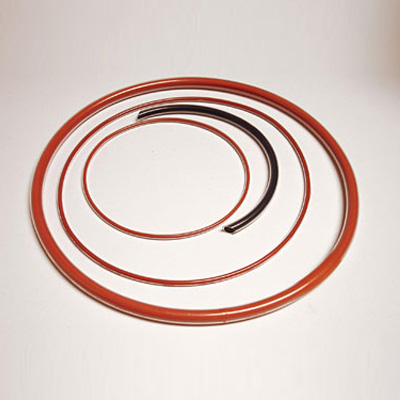FEP ENCAPSULATED O-RINGS
A FEP/PFA Encapsulated O-ring cosists of a seamless FEP/PFA jacket over an elastomer core. This combination of chemically resistant polymer jacket over a low-compression set elastomer provides unique properties for a range of demanding applications.
- Chemically resistant
- Wide range of thermal stability
- Low permeability
Elasticity with the highest media stability – encapsulated FEP O-rings offer excellent operational safety in superior static seals.
The combination of an elastomer O-ring and a closed sheath made of modified PTFE (FEP) makes our FEP O-rings the ideal sealing component against aggressive media while maintaining highly elastic properties for optimal contact pressure as only an elastomer can provide.
Depending on the required temperature stability, FKM or VMQ is used as the core material. The encapsulation is made of FEP or PFA. Due to the encapsulation, the range of applications focuses exclusively on static seals.
These are available in almost all required dimensions, internal diameters and cross sections in inch and metric and with both the encapsulation and on request the elastomer core being FDA compliant.
- Highly stable in almost all chemicals
- Universally applicable
Dimensions that are independent of tools, in many cases in stock
Function
- Elastomer core ensures elastic contact pressure
- FEP or PFA encapsulation provides effective protection against aggressive media
- The combination of an elastomer O-ring and a closed sheath made of modified PTFE (FEP) makes our FEP O-rings the ideal sealing component against aggressive media while maintaining highly elastic properties for optimal contact pressure as only an elastomer can provide.
Material Available
There are several combinations of materials and available and the application itself should determine the choice.
Viton core with FEP jacket
This choice gives the best possible sealing characteristic s due to very low compression set value of the specially formulated Viton core. Unless there are extreme high or low temperatures involved, Viton core should be the first choice.
Temp range :- 4F (-20C) to +400F (+204C)
Silicone Core with FEP jacket
Whilst technically inferior to Viton as a seal material, Silicone does have the ability to work at lower temperatures than Viton.
Temp range :- -70F (-60C) to +400F (+204C)
Viton core with PFA jacket
The only advantage of this combination is the extra abrasion resistance of the PFA jacket
Temp range :- 4F (-20C) to +400F (+204C)
Silicone Core with PFA jacket
Silicone combined with PFA has a very flexible temperature range, especially at the higher end.
Temp range :- -70F (-60C) to +500F (+260C)
Hollow Silicone core with FEP jacket
Used in applications where low loading requirements are necessary i.e. glassware or similar delicate equipment. The seal compresses easier than a solid core ring.
Temp range :- -70F (-60C) to +500F (+260C)
Hollow Silicone core with PFA jacket
Again the same applications as above but capable of higher temperature.
Temp range :- -70F (-60C) to +500F (+260C)
When not to use Encapsulated O Rings
Despite the many advantages that our Ncap’s offer, there are applications where their use prohibited.
Dynamic application
We do not recommend the use of Ncap’s in any kind of dynamic environment. Even relatively low speed with good surface finishes will result in premature failure of jacket. Ncap’s are truly static seals.
Abrasive media
When abrasive liquids slurries or powered are brought into contact with seal it is likely that the thin wall jacket will become damage in a short time. Both FEP and PFA do not have good wear resistance.
Stretching
Excessive stretching of Ncap’s may rapture the jacket and break the core materials. As a guide we say that the ring should not be stretched more than 2x Csd and even than strictly in accordance to the fitting instructions which appear in this section.
Collapsing
Opposite to the above stretching problem collapsing a Ncap into a bore can have damaging effects by severe kinking of the jacket material. It is very important that pre heating of the seal is conducted see fitting instructions.
High pressure
One of the most common causes of high pressure failure is too large an extrusion gap. This result in damage to the jacket and will certainly destroy the O Ring in very short period of operation below you can see a typical example of ‘jacket extrusion’


